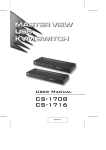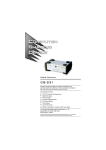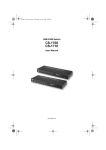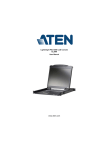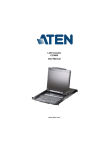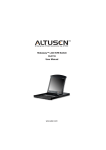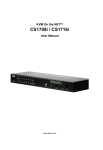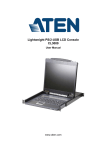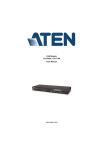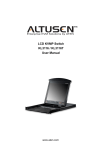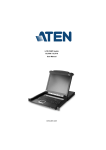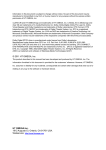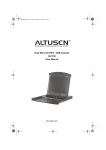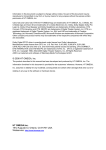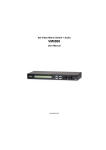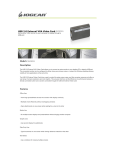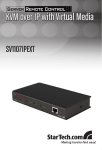Download Manual - Iogear
Transcript
Installation Guide GCN1000 PCPortal GCN1000 PART NO. M0566 Table of Contents Package Contents 4 Conventions System Requirements 5 The Java Client 35 Java Applet Tool Bar 36 Video Parameters Video Keypad Operating systems Mouse Synchronization 38 Components 6 Message Board Computer Preliminary Setup 8 Administrator Reset 40 GCN1000 Preliminary Setup 9 Connecting from the internet 41 GCN1000 Initial Configuration 11 Troubleshooting 43 Hardware Setup Table of Contents 13 General Operation Normal Logon 14 Java Applet Utility Icons 15 Windows Client 44 Administration Icons 16 Additional Mouse Synchronization Procedures 45 Network 17 Windows 2000 Access ports IP Address Windows XP / Vista / Server / Server 2003 18 Optional Cable DNS server IP Change Notification Security 19 Overview Filtering User Station Filtering: IP Address 20 User Station Filtering: MAC Address User Manager 21 Customization 22 Firmware 23 Windows Client 25 Operation 27 Windows Client Control PNEL Hotkey setup 29 Video ADJUSTMENT 30 Message Board 31 Virtual Media 33 3 46 Package Contents The GCN1000 package Contains: • 1 GCN1000 • 1 USB Custom KVM Cable Set • 1 Ethernet cable (6ft) • 1 Custom USB Console Cable Set • 1Virtual Media USB Cable (mini B to A) • 1 User Manual Check to make sure that all the components are present and that nothing was damaged in shipping. If you encounter a problem, contact your dealer. Caution Read this manual thoroughly and follow the installation and operation procedures carefully to prevent any damage to the unit, and/or any of the devices connected to it. Conventions : This manual uses the following conventions: Monospaced Indicates text that you should key in. [ ] Indicates keys you should press. For example, [Enter] means to press the Enter key. If keys need to be chorded, they appear together in the same bracket with a plus sign between them: [Ctrl+Alt]. 1. Numbered lists represent procedures with sequential steps. • Bullet lists provide information, but do not involve sequential steps. −> Indicates selecting the option (on a menu or dialog box, for example), that comes next. For example, Start −> Run means to open the Start menu, and then select Run. Indicates critical information. NOTE: Because of the uniqueness of the GCN1000 and its operation: at any given time either computer can be considered the local or the remote computer. To avoid confusion the following convention is used: Local computer: The computer the GCN1000 is physically attached to Remote computer The computer that is accessing the GCN1000 from the network or internet. 4 System Requirements • For best results, we recommend that the computers used to access, the GCN1000 control unit have at least a P III 1 GHz processor, with the screen resolution set to 1024 x 768. • Browsers must support 128-bit SSL data encryption. • We recommend that the internet connection speed be at least 128 kbps. • For the browser-based Windows Client, you must have DirectX 7.0 or higher installed. • For the browser-based Java Applet, you must have Sun’s Java Runtime Environment Version 6 Update 3 or higher. • Your router and ISP must support Port Forwarding to allow access from the internet. Video The unit supports the following resolutions and refresh rates. Resolution Refresh Rates 640x480 60, 72, 75, 85 720x400 70 800x600 56, 60, 72, 75, 85 1024x768 60, 70, 75, 85 1152x864 75 1280x1024 60, 75 Operating Systems Supported operating systems: OS Version Windows Linux UNIX Novell 2000 and higher RedHat 9 and higher SuSE 10 and higher Mandriva (Mandrake) 2007 and higher AIX 4.3 and higher FreeBSD 6 and higher Netware 6 and higher 5 Components Front View 1 2 3 4 5 No. Component Description 1 Reset Switch System Reset: Pressing and holding this switch in for more that three seconds performs a system reset. Restore Factory Default Settings: Power off the GCN1000, then press and hold the reset switch for at least 3 seconds while reconnecting power. Note: This will not reset users or passwords 2 10/100 Mbps LED The LED lights ORANGE to indicate a 10 Mbps connection, and GREEN to indicate a 100 Mbps connection. 3 Link LED Flashes GREEN to indicate that a Client program is accessing the device. 4 Power LED Lights ORANGE when the GCN1000 is powered and ready to operate. 5 LAN Port The network’s Ethernet cable connection 6 PCI Interface 4 1 3 2 No. Component Description 1 Power Jack The power adapter connection. 2 PC/KVM Port The connection for the cable that links the GCN1000 to your computer. 3 USB Console Port This is the connection for the local console cable (USB keyboard, monitor, and USB mouse). Each port is color coded and marked with an appropriate icon for identification. * 4 Virtual Media Port The connection for the virtual media cable that connects the GCN1000 to a USB port on your computer. It allows file transfers to occur 5 LAN Port The network’s Ethernet cable connection * Note: if you are using a wireless keyboard/mouse set, connect the receiver to the Keyboard port of the KVM cable 7 Computer Preliminary setup Find your computer’s IP address and default Gateway 1. Go to Start −> RUN 3. Enter CMD in the box 4. [OK] or [Enter] A command line window opens 5. Type ipconfig Package Contents 6. [Enter] Look for the heading that says Ethernet adapter Local Area Connection: 7. Write down the IP Address and Default Gateway. If the first three groups of numbers of your IP Address happens to be 192.168.0. Proceed to Hardware set up IP Address .................................................................................................................................... Default Gateway ........................................................................................................................... Exit the command line by clicking on the “X” on the top right corner of the Command line window 8 GCN1000 preliminary setup Connect the GCN1000 and your computer to your network using the following diagram. This is a preliminary set up so no other connections are needed. What Is RAID? Most home networks use automatic IP Addressing, and the GCN1000 is provided with a default fixed IP address of 192.168.0.60: so to log in for the first time, you must have your computer and the GCN1000 on the same network. Be sure to write down your existing settings prior to changing anything so you can return to them after the initial set up The following instructions will explain how to put your computer and GCN1000 on the same network, the first set of instructions cover Windows XP and 2000, the second set explains Vista. Windows XP and 2000 1. Go to control panel look for the Network Connections icon 2. Double click on the icon 3. Right click on Local Area Connection (or Wireless network connection) 4. Select Properties 5. Under the General tab highlight Internet Protocol TCP/IP 6. Click on properties 7. Click on the Radio button “Use the following IP address” In the top block labeled “IP Address” Enter: 192.168.0.65 In the center block labeled “Subnet Mask” Enter: 255.255.255.0 Click on OK – your computer will take a few moments to change its IP address 9 Windows Vista 1. Go to control panel 2. Select “Network and Sharing Center” 3. Select “Manage network connections” 4. Select “Local area Connection” right click select “Properties” 5. Highlight “Internet Protocol Version 4 (TCP/IPv4) 6. Select [Properties] 7. Select “Use the following IP address” In the top block labeled IP address type 192.168.0.65 Enter 255.255.255.0 for the Subnet mask Leave the default Gateway blank 8. Click [OK] – your computer will take a few moments to change its IP address 10 GCN1000 Initial configuration 1. Open your web browser. You will get a “Page cannot be displayed” error message, this is normal. 2. Type http:// 192.168.0.60 in address bar of your web browser, then [ Enter ] 3. When the certificate windows pop up, accept them. 4. When the below screen appears, log into the GCN1000: User name: administrator (lowercase) Password: password (lowercase). 5. After logging in, click on the Network icon along the top of the Window. This is where the GNS1000’s network configuration settings and information are located. 11 6. Select Set IP address manually (A static IP Address is preferred) The actual address you use is dependent on your network’s address range: The following is an example: In the preliminary set up, the IP Address noted is 192.168.1.16, so the IP Address you would enter would be 192.168.1.60 IP Address assigned …………………………. 6. Select Obtain DNS server address automatically, 7. For now leave the rest of the settings at their default values (they will be covered latter) 8. Click on Apply then Logout, The GCN1000 will reset. (It is important to log out so the GCN1000 will close the connection) NOTE: Change your computer’s IP address and Default Gateway back to the original settings as noted in the preliminary Steps (if both are obtained automatically, click on the radio button to restore your settings). Reconnect the computer to your network; connect the GCN1000 into your system as described in the following section: 12 Hardware Setup Ensure that power has been removed from all devices in the installation. You must unplug the power cords of any computers that support Keyboard Power On function. Installation To install the GCN1000, refer to the installation diagram: 1. Use the Console cable provided to connect the GCN1000’s Console port, to the local keyboard, monitor and mouse, they are color coded for identification. 2. Use the KVM cable provided to connect the GCN1000’s PC/KVM port, to the video and a USB port on the computer. 3. Connect your network cable between the GCN1000’s LAN port and your router. 4. Connect your computer to the network. Note: Both the GCN1000 and your computer must be connected to your router. If you are using a wireless network , switch to a wired connection to set up the GCN1000, once you know everything is working you can switch back to wireless Note: The GCN1000 to router connection must be wired. 5. Connect the mini B to A -USB connector between GCN1000 Virtual Media port and a USB port on your computer. 6. Connect the power adapter cable to the GCN1000’s power jack Installation Diagram: 13 Normal Logon To operate the GCN1000 from an Internet browser, begin by logging in: Open your browser and specify the IP address (assigned in the preliminary set up) of the GCN1000 in the browser’s Address bar. 1. A Security Alert dialog box, similar to the one below, appears. Accept the certificate. If a second certificate appears, accept it as well. The GCN1000 login page appears: Provide a valid Username and Password Default: User name : administrator Password : password Click on Login 14 The GCN1000 Main Screen appears: The Main Screen consists of: Utility icons arranged vertically down the left side Administration icons arranged across the top; Utility icons Icon Purpose Apply: Saves the changes you make in the administration dialog boxes, but does not implement the changes, which go into effect when you enable Reset on exit (see Customization) and log out. Windows Client: Allows users with the proper permission (see User Manager) to connect to the GCN1000 using Windows software, to remotely control the server. Java Applet: For platform independence, the Java applet allows users with the proper permission (see User Manager ) and Java installed on the remote computer, to connect to the GCN1000 and remotely control the sever. Log: All the events that take place on the GCN1000 are recorded in a log file. If you have the proper permission clicking on this Icon displays the contents of the log file Note: See the next page for an explanation of the Log utility. Logout: Click this icon to log out and end your session Note: It is important to end your session, so the CN1000 can terminate the session. If you get a “System in use” error message its because the session ended with out Logging out, Logon with the other Client. 15 The Log File Screen The GCN1000 logs events that occur regarding the unit. The file is an event database that records the last 512 events overwriting the oldest events on a continuing basis. To clear the log file, click on the Clear Log icon at the lower right of the page. To view the contents of the log file, click the Log icon at the lower left of the page. Administration Icons The icons arranged horizontally across the top of the page are linked to the administration utilities, which are used to configure the GCN1000. Your ability to make configuration changes depends on the permissions associated with your login information. This chapter discusses each of them in turn. Once you login, the General panel displays on the browser window. It is the first of the Administration pages, and provides information about the GCN1000’s status: 16 An explanation of each of the fields is given in the table below: Field Explanation Device Name: To make it easier to manage installations that have more than one GCN1000, each one can be given a name. To assign a name for the GCN1000, type in one of your choosing (16 characters max.). MAC Address: Displays the GCN1000’s MAC Address. Firmware Version: Indicates the GCN1000’s current firmware version level. Network The Network dialog is used to specify the GCN1000’s network environment. Access Ports If a firewall is being used, the Administrator can specify (in the Firewall’s set up) the port numbers that the firewall will allow. Users must specify the port number as part of the IP address when they connect to the GCN1000. If an invalid port number (or no port number) is specified, the GCN1000 will not be found. I.E. 192.168.0.60 / 9000 (for the Windows client) and 192.168.0.60/9002 for the Java client. Explanations of the fields are given in the table below: Field Explanation Program This is the port number that must be specified when connecting from the Administrator and Windows Client. Valid entries are between 1024 -60,000 Java This is the port number used for Java connections. Valid entries are between 1 - 65535 17 Note: 1. If there is no firewall (on an Intranet, for example), it does not matter what these numbers are set to, since they have no effect. 2. The access ports cannot have the same value. You must set a different value for each one. IP Address The GCN1000 can have its IP address assigned dynamically at boot-up (DHCP), or it can be given a fixed IP address. Recommendation: If you wish to access the GCN1000 from the internet, assign a static IP address because you will need to configure your router to forward the port to the GCN1000 and an IP address is the most reliable way to connect.. To specify a fixed IP address, select the “Set IP address manually” radio button and fill in the IP address you wrote down in the preliminary steps (it should still be there). The subnet mask is 255.255.255.0 The Default Gate way is the IPAddress of your router DNS Server The GCN1000 can have its DNS server address assigned automatically, or a fixed address can be specified. • For automatic address assignment, select “Obtain DNS server address automatically” (Recommended) • To specify a fixed address, select “Use the following DNS IP Change Notification If you elect to use automatic IP Addressing, you can have the GCN1000 send an e-mail notification whenever its DHCP assigned IP address changes. • To enable e-mail notification, select the Enable check box, fill in the domain name or IP address of your SMTP server, and specify the From: and To: e-mail addresses. • If your SMTP server requires authentication, select the My server requires authentication check box and fill in the Account Name and Password fields with a valid user account name and password. • After filling in all the appropriate fields, click the Test button to test the operability of the e-mail notification. An e-mail should be sent to the e-mail address specified in the To: field Note: This will only notify you if the GCN1000 changes its address on your local network, it will not notify you if your external address changes. 18 Security The Security page is used to control access to the GCN1000. Software Installation Overview • IP and MAC Filters control access to the GCN1000 based on the IP and/or MAC addresses of the computers attempting to access the system. If any filters have been configured, they appear in the IP Filter and/or MAC Filter list boxes. • The Login string lets the Administrator specify a string that users must include along with the GCN1000’s IP address when they access the GCN1000 with the Java Applet. For example, if the IP address were 192.168.0.126, and the string was abcdefg, the users would key in the following: 192.168.0.126/abcdefg Users must include a forward slash and the string along with the IP address when they log in. For security purposes, we recommend that you change this string from time to time. Filtering To enable IP and/or MAC filtering, a check mark in the IP Filter Enable and/or MAC Filter Enable checkbox enables the filter. There are a maximum of 100 filters allowed for each option. • If the include button is checked, all the addresses within the filter range are allowed access to the GCN1000; all other addresses are denied access. • If the exclude button is checked, all the addresses within the filter range are denied access to the GCN1000; all other addresses are allowed access. 19 User Station Filtering – IP addresses: To add an IP address filter: 1. Click Add. A dialog box similar to the one below appears: 2. Specify the filter address in the dialog box, and then click OK. A second dialog box, similar to the one below, appears: Windows XP Existing Installation 3. To filter a single IP address, key in the same address as the start IP Address. To filter a continuous range of addresses, key in the end number of the range. 4. After filling in the address, click OK. 5. Repeat these steps for any additional IP addresses you want to filter. To delete a filter, select it and click Remove. To modify a filter, select it and click Edit. The Edit dialog box is similar to the Add dialog box. When it comes up, simply delete the old address and replace it with the new one. User Station Filtering –MAC addresses: To add a MAC address filter Click Add. A dialog box similar to the one below appears: 1. Specify the MAC address in the dialog box, then click OK. 2. Repeat these steps for any additional MAC addresses you want to filter. To delete a filter, select it and click Remove. To modify a filter, select it and click Edit. When it dialogue box comes up, simply delete the old information and replace it with the new one. 20 User Manager The User Management page is used to create and manage user profiles. Up to 8 user profiles can be established. To add a user profile, fill in the information asked for in the User Info panel and click Add. The user’s name appears in the User List panel. To delete a user profile, select it from the names displayed in the User List panel, and click Remove. The user’s name is removed from the User List panel. To modify a user profile, first select it from the list in the upper panel; then change the information that appears in the User Info dialog box. The Reset button clears all the information shown in the User Info fields. When you have made all your changes, click Update. Note: For security, purposes change the default user name and password Note: The user’s password is not displayed – the Password and Confirm fields are blank. If you do not want to change the user’s password, simply leave the two fields blank (not recommended). If you do want to change the user’s password, key the new password in the Password field, then key it in again in the Confirm field. 21 An explanation of the profile items is given in the table below: Item Explanation User name A minimum of 6 and a maximum of 16 characters are allowed. Password A minimum of 8 and a maximum of 16 characters are allowed. Confirm Password To be sure, there is no mistake in the password, you are asked to re-enter it. The two entries must match. Description Additional information about the user that you may wish to include. Permissions Federal A check mark grants permission, no check mark denies permission to the profile being created or modified. Configure: Administrator privileges, which allows the user to set up and Communications Commission modify the GCN1000’s (FCC) operatingStatement environment. / CE Statement Windows Client: allows access the GCN1000 via the Windows Client software. Java Operation: Java Operation access the GCN1000 via the Java Applet software. Virtual Device: Enables Virtual Media Log: allows viewing the contents of the log file. View Only: Limits a user to viewing the video display of the remote connection. Note: If a user is denied a permission, that permission is not visible on the Utility tool bar when that user logs on Customization This configuration page allows the Administrator to set Timeout, Login failure, and Working mode parameters. 22 An explanation of the Customization parameters is given in the table below: Parameter Explanation Time out Control If the GCN1000 does not receive any input from a computer that is accessing it with either client within the time specified, the connection terminates. Login failure Login failures allowed: Sets the number of consecutive failed login attempts that are permitted from a remote computer. Login failure timeout: Sets the amount of time a remote computer must wait before attempting to login again after it has exceeded the number of allowed failures. Working Mode Enable stealth mode: With stealth mode enabled, the GCN1000 will not reply to a ping request. Reset on exit A check here causes the GCN1000 to reset itself and implement all the new changes when you log out. A wait of approximately 30 to 60 seconds is necessary before logging in following the reset. Firmware As new versions of the GCN1000 firmware become available, they can be downloaded from our website. Check the website regularly to find the latest information and packages. To upgrade the firmware, do the following: 1. After downloading the new firmware file to your computer, open your browser; log in to the GCN1000; and click the Firmware icon to bring up the Firmware File dialog box: 2. Click Browse; navigate to the directory that the new firmware file is in and select the file. 3. Click Upload. 4. After the upload completes, click the Apply icon at the left of the web page. 5. Enable the Reset on exit checkbox on the Customization page. 6. Click the Apply icon at the left of the web page, again. 7. Click the Logout icon at the upper right of the web page to exit and reset the GCN1000. 23 Using the GCN1000 This completes the GCN1000 configuration. The following chapters and steps explain how to use the unit. We start by accessing the unit through your local network to verify the settings are correct and operate the way you want them to. Once the setup is confirmed on your local network the finial step will be to connect through the internet. Required equipment A networked computer, either on your network or on the internet, that meets the following minimum requirements (you cannot use the computer that is directly connected to the GCN1000) • P III 1 GHz processor, • A screen resolution set to 1024 x 768. • A browsers supporting 128-bit SSL data encryption (all current browsers support 128-bit SSL data encryption) • We recommend that the internet connection speed be at least 128 kbps. • For the browser-based Windows Client, you must have DirectX 7.0 or higher installed. • For the browser-based Java Applet, you must have Sun’s Java Runtime Environment Version 6 Update 3 or higher Connecting from your local network 1. Ensure the “remote” computer is connected to your network 2. Ensure the GCN1000 is connected to your local network 3. Start the browser of your choice on the remote computer 4. Type in the IPAddress you wrote down in step 6 of GCN1000 Initial configuration for example http://192.168.1.60 hit the enter key 5. You will be taken to the GCN1000 Logon screen 6. Enter your user name and password in the spaces provided and click on Logon 24 7. This brings you to the GCN1000 main screen Contact Using The Windows Client 1. After you log in, click the Windows Client icon on the left of the web page. Note: You must have DirectX 7.0 or higher installed on you computer. Note: If you are using Internet Explorer 6 or above a box similar to the one below opens when connection to the GCN1000 has been established Some browsers may not allow the client to run directly in their window in those cases, you will be asked to “Save to disk”. Allow it to download to a convenient location, then, with the browser still open, double click on the down loaded application , a box similar to the one below opens. There is nothing actually installed on your computer, the application is merely run from your computer (instead of directly through the browser). In keeping with the security provisions above, if you use the “Save to disk” method, each time you use the Windows client a fresh copy of the program will be down loaded. 2. When a connection to the GCN1000 has been established, a screen similar to the one below appears: 25 Explanations of the selection boxes are given in the following table. Full Screen Mode Enabled Disabled If Full Screen Mode is enabled, the remote display fills the entire screen of your local monitor. If Full Screen Mode is not enabled, the remote display appears as a window on your desktop. If the remote screen is larger than what is able to fit in the window, move the mouse pointer to the screen border that is closest to the area you want to view and the screen will scroll. Note: Clicking the pushpin icon in the remote display’s title bar will cause the window to remain on top of all other open windows on your desktop. If Keep Screen Size is enabled, the remote screen is not resized. Keep Screen Size Enabled If Keep Screen Size is not enabled, the remote screen is resized to fit the resolution of your monitor. If the remote resolution is smaller, its display appears as a window centered on your screen. Disabled If the remote resolution is larger, its display is centered on your screen. To access the areas that are off screen, move the mouse to the corner of the screen that is closest to the area you want to view and the screen will scroll. Switch Clicking on the Switch takes over console control of the unit to which the GCN1000 is connected. Exit Click to exit the Windows Client program. 26 Operation After you click on the [Switch] button, the remote system appears on your monitor. You can work on the remote system via the screen display on your monitor just as if it were your local system. Note: the screen depicted is for printing only, your actual view in will be color • You can move the window to any convenient location on your desktop by dragging it from the title bar. • You can switch between your local and remote programs with [Alt + Tab]. Note: 1. Due to net lag, there might be a delay before your keystrokes show up. You may also have to wait a bit for the remote mouse to catch up to your local mouse before you click. 2. Due to net lag, or insufficient computing power on the local machine, some images, especially motion images, may display poorly. The Windows Client Control Panel The Windows Client control panel – located at the bottom right of the screen – provides utilities to help you control remote KVM operations. 27 The panel consists of an icon bar with two text bars below it. The text bars display the video resolution and IP address of the remote device. The functions of icons are described in the table on the next page. Icon Function Brings up the Hotkey Setup dialog box Brings up the Video Adjustment dialog box. (Right click for fast Auto Sync.) Opens the Message board Brings up the Virtual device dialog box Sends Ctrl + Alt + Del from the remote to the local computer. Exit the Windows Client These icons show the Num Lock, Caps Lock and Scroll Lock state. When the icon is “lit”, the function is active. When connected, toggle the LEDs to set the correct state Note: You can move the control panel to any convenient location on the remote window’s screen by dragging it from the title bar. The Windows Client Control Panel icons and their functions are described in the sections that follow. 28 Hotkey Setup Various actions related to manipulating the remote server can be accomplished with hotkeys. The Hotkey Setup utility (accessed by clicking the Keyboard icon on the Control Panel), lets you configure which hotkeys perform the actions. The actions are listed in the left panel; the hotkeys that invoke them are shown in the panel at the right. If you find a default Hotkey combination inconvenient, you can reconfigure it by following these five steps: 1. Highlight the Action, and then Click Start. 2. Key in the Function keys (one at a time). The key names appear in the Key field as you press them. 3. When you have finished keying in your sequence, Click Stop. 4. Click Set. Repeat for any other actions you wish to change. 5. Click Close. Note: You can use the same function keys for more than one action, as long as the first key is not the same. For example, you can use F1 F2 F3 for one action; F2 F1 F3 for another; F3 F2 F1 for a third, etc. 29 An explanation of Hotkey actions are given in the table below: Action Explanation Exit remote location Ends the remote connection to the GCN1000 and returns to local operation. Adjust Video Brings up the video setting dialog box. Toggle OSD Toggles the control panel Off and On. Toggle screen mode Toggles the screen display between full screen and windowed modes. Adjust mouse This utility synchronizes the local and remote mouse movements following a video resolution change. After invoking this utility, simply click the local mouse pointer on top of the remote mouse pointer. Substitute Alt key Although all other keyboard input is captured and sent to the GCN1000, [Alt + Tab] and [Ctrl + Alt + Del] work on your local computer. In order to implement their effects on the remote system, another key may be substituted for the Alt key. If you substitute the F12 key, for example, you would use [F12 + Tab] and [Ctrl + F12 + Del]. Substitute Ctrl key If your local computer captures Ctr. key combinations, preventing them from being sent to the remote system, you can implement their effects on the remote system by specifying a function key to substitute for the Ctrl key. If you substitute the F11 key, for example, pressing [F11 + 5] would appear to the remote system as [Ctrl + 5]. Note: To invoke an action, you must press and release one key at a time. Video Adjustment The Video options dialog box allows you to adjust the placement and picture quality of the remote screen (as displayed on your monitor). To bring up the dialog box, either click on the Hammer icon on the Control Panel, or use the Adjust Video hotkeys. The following screen appears: 30 Option Usage Screen Position Adjust the horizontal and vertical position of the remote computer window by clicking the Arrow buttons. Auto-Sync Click Auto-Sync to have the function detect the vertical and horizontal offset values of the remote screen and automatically synchronize it with the local screen. If the local and remote mouse pointers are not in sync, in most cases, performing this function will bring them back into sync. Note: This function works best with a bright screen. If you are not satisfied with the results, use the Screen Position arrows to position the remote display manually. RGB Drag the slider bars to adjust the RGB (Red, Green, and Blue) values. When an RGB value is increased, the RGB component of the image is correspondingly increased. Video Quality Drag the slider bar to adjust the overall Video Quality. Values range from minimum to maximum. The larger the value, the clearer the picture and the more video data goes through the network. Depending on the network bandwidth, a high value may adversely effect response time. Noise Noise refers to a grainy effect caused by random color speckles in the display. Drag the slider to achieve the desired effect. The Message Board The GCN1000 supports two user logins, [only one user has control at a given time] which can possibly give rise to access conflicts. To alleviate this problem, a message board feature has been provided, allowing users to communicate with each other. The message board functions much as an internet chat program does. When you click the Message Board icon on the Windows Client tool bar, a screen similar to the one below appears: 31 Compose Panel Key in the messages that you want to post to the board in this panel. Click Send, or press [Enter] to post the message to the board Message Display Panel Messages that users post to the board - as well as system messages - display in this panel. If you disable Chat, however, messages that get posted to the board will not appear. User List Panel [below] The names of the logged in users are listed in this panel. • Your name appears in blue; the other users’ name appears in black. • By default, messages are posted to all users. To post a message to one individual user, select the user’s name before sending your message. • If a user’s name is selected, and you want to post a message to all users, select All Users before sending your message. • If a user has disabled Chat, its icon displays by the user’s name to indicate so. • If a user has occupied the KVM or the KM, its icon displays by the user’s name to indicate so. 32 Enable / Disable (Chat) When disabled, messages posted to the board are not displayed. The button is shadowed when Chat is disabled. The Icon displays next to the user’s name in the User List panel when he has disabled Chat. Occupy / Release (Keyboard / Video / Mouse) When you Occupy the GCN1000, other users cannot see the video, and cannot input keyboard or mouse data. The button is shadowed when the unit is occupied. The icon displays next to the user’s name in the User List panel when he has occupied the GCN1000 Occupy / Release (Keyboard / Mouse) When you Occupy the GCN1000, other users can see the video, but cannot input keyboard or mouse data. the button is shadowed when the unit is occupied. The icon displays next to the user’s name in the User List panel when he has occupied the GCN1000 Show / Hide (User List) When you hide the User List, the User List panel closes. The button is shadowed when the User List is open Exit Click to close the message board Note: Only the logged on users can see the Message Board, it is not visible on the local monitor Virtual Media The GCN1000’s Virtual Media feature allows a USB 2.0 device (Floppy drive, or Flash Drive), on a remote system, to act, as if it were installed on the local server Note: The Virtual Media function is: Only supported by the Windows Client on computers running Windows 2000 or higher. Not supported on computers using other operating systems (for example Linux). not supported on any computer via the Java Client software. Connect the (mini B to A) USB cable between the Virtual Media port on the GCN1000 and a USB port on the local computer. Connect a USB mass storage device to a USB port on the remote Computer. From the remote computer click on the Virtual Media icon in the Windows Client Control Panel, this opens the Virtual Media Connection dialog box: Note: More than one USB mass storage device may be connected and recognized, but only the unit selected can be accessed. 33 1. Drop down the Physical Device list to select the appropriate drive. 2. After you have made your media source selection, click Connect [the Connect button changes to Disconnect]. Open “My Computer” on the remote computer and the selected device will appear as a connected drive, files may, then be transferred between the drive and local computer. 3. To end the connection, bring up the dialog box and click Disconnect*. *Note: the connection remains open until the disconnect button is pressed. 34 The Java Applet The Java Applet makes the GCN1000 accessible to all supported platforms that have Java 2 installed. Java 2 is available for free download from Sun’s Java web site (http://java.sun.com). Note: To verify your configuration and to become familiar with using the applet, the first step is to access the GCN1000 from your local network, once your configuration has been proven, the internet connection will be covered To Access the Java applet: Connecting from your local network 1. Ensure the “remote” computer is connected to your network 2. Ensure the GCN1000 is connected to your local network and to the local computer 3. Start the browser of your choice on the remote computer. 4. Type in the IPAddress you wrote down in step 6 of GCN1000 Initial configuration for example http://192.168.1.60 hit the enter key. 5. You will be taken to the GCN1000 Logon screen 6. Enter your user name and password in the spaces provided then click on Logon 7. This brings you to the GCN1000 main screen 35 8. Click on the Java Icon After a few seconds the remote server’s display appears as a window on your desktop: Navigation You can work on the remote system via the screen display on your monitor just as if it were your local system. • You can maximize the window, drag the borders to resize the window; or use the scroll bars to move around the screen. • You can switch between your local and remote programs with [Alt + Tab]. Notes: 1. Due to net lag, there may be a slight delay before your keystrokes show up. You may also, have to wait for the remote mouse to catch up to your local mouse before you click. 2. Due to net lag, or insufficient computing power on the local machine, some images, especially motion images, may display poorly. The Java Applet Toolbar The Java Applet’s toolbar provides utilities to help you control remote KVM operations. NOTE: The tool bar is hidden in the blank area at the bottom center of the screen, and appears when you move the mouse pointer over the area 36 The Tool Bar Icons and their functions are explained in the table below Set Video Parameters: Brings up the Video settings dialog box Keypad: Brings up the Keypad options Mouse Synchronization: Initiates the mouse synchronization process Lock Key LEDs: The “LEDs” show ( from left to right), the Num Lock, Caps Lock, and Scroll Lock status of the local computer When the Icon is “Lit”, the lock is active Clicking on the icon toggles the mode. Note: When first connected, toggle the LEDs to set the correct state The Video resolution and refresh rate of the remote computer are displayed below the lock icons. Message Board: Brings up the Message board Sends a Ctrl+Alt+Del signal to the local system Exits the program. Note: Does not close the session. Set Video Parameters: Clicking on this button brings up the Video settings dialog box 37 This is similar to the Video Adjustment feature of the Windows Client... Note: We recommend that you perform Auto sync right after you connect for improved mouse synchronization. Keypad Since some locally input keyboard combinations cannot be captured and sent to the GCN1000, the Keypad provides a one-click implementation of their actions on the remote system. Mouse Synchronization At times, the local mouse movement may lose sync with the remote mouse movement. You can try getting them back in sync with fast mouse synchronization by moving the mouse pointer down into the Java Applet toolbar. If that does not help, run Auto sync (as discussed on the previous page). If Auto sync does not resolve the problem, the Mouse Synchronization function can get them back into sync. This is similar to the Mouse Synchronization feature of the Windows Client. 1. Click the Mouse Synchronization button. The remote mouse pointer moves to the upper left area of the screen. 2. Move your local mouse pointer directly over the remote mouse pointer and Click. mouse adj. Note: If you experience mouse Synchronization problems there are additional mouse settings described in the Appendix The Message Board The GCN1000 supports two user logins, [only one user has control at a given time] which can possibly give rise to access conflicts. To alleviate this problem, a message board feature has been provided, allowing users to communicate with each other. The message board functions much as an internet chat program does... When you click the Message Board icon on the Java Applet toolbar, a screen similar to the one below appears: 38 Note: Only the logged on users can see the Message Board, it is not visible on the local monitor The Button Bar - buttons on the Button Bar are toggles. Enable/Disable Chat. When disabled, messages posted to the board are not displayed. The button is shadowed when Chat is disabled. The icon displays next to the user’s name in the User List panel when he has disabled Chat. Occupy/Release Keyboard/Video/Mouse. When you Occupy the KVM, other users cannot see the video, and cannot input keyboard or mouse data. The button is shadowed when the KVM is occupied. The icon displays next to the user’s name in the User List panel when he has occupied the KVM. Occupy/Release Keyboard/Mouse. When you Occupy the KM, other users can see the video, but cannot input keyboard or mouse data. The button is shadowed when the KM is occupied. The icon displays next to the user’s name in the User List panel when he has occupied the KM. Enable/Disable Message Board on Top. When enabled, the Message Board always displays on top of other screen elements. 39 Administrator Reset: The following procedure will reset the default user name and password if you are unable to perform an Administrator login because the Username and Password information has become corrupted or lost. To clear the login information (and return all settings to their defaults), do the following: 1. Disconnect the power adapter and all cables. 2. Remove the housing from the GCN1000. 3. Short jumper J9 on the circuit board. 4. Reconnect the GCN1000 power adapter. 5. When the front panel LEDs flash, disconnect the power adapter from the GCN1000. 6. Remove the jumper cap from J9. 7. Close the housing and reconnect the GCN1000 power adapter and cables. 8. After starting back up, you can use the default Username and Password to log in. Note: Performing this procedure also returns all settings to their defaults. It will not remove Users or their passwords. 40 Connecting From the Internet For the following steps, disable your network firewall* to simplify the set up, once you have connected to the unit from the internet restore your firewall. You will need to configure the firewall to pass the ports you selected for the Windows and Java clients (9000 and 9002 are the default ports) * If you have one. A firewall running on your computer such as Zone Alarm or Norton will not affect the setup Because each router manufacture / ISP / and Dynamic DNS service is slightly different, the following steps are general in nature and serve only as guidelines. If you have specific questions, please contact your router’s manufacturer, ISP, or the FAQ s page of the Dynamic DNS service for assistance. The following three items are needed to connect to the GCN1000 from the internet 1. A method to find the current IP address of the GCN1000 (on your network) if you did not assigned it a static IP Address. Some routers can use the name of the network device to locate it on your net work. The network name of the GCN1000 can be found under Device Name in the information box located on the GCN1000’ s main screen after logging on 2. A method to find you current external IP address. ISPs assign temporary external IP address so; unless you purchased a static IP address from your ISP, you have a dynamic IP address that changes periodically) 3. A method by which your router knows where to direct the incoming Client software This is Port forwarding it is set up to direct the incoming Client to the GCN1000 Step 1 If you have assigned a static IP address to the CN1000, this step can be skipped. The GCN 1000 has a feature called IP Change Notification. This feature will automatically send an Email to your preferred Email account notifying you its IP addressed has changed and includes the new address. Fill out the form (contact your ISP if you are unsure of the information) after all information has been entered press the Test button to ensure it works. Note: The above step will only notify you of the GCN1000’s address change it will not update your external IP Address (this will not ensure access form the internet) Step 2 Once the above has been completed: Find a service provider that can monitor you current internet IP address Most routers provide native support for at least one free service. If it does not, or you have a different preference, an internet search for Dynamic DNS will produce a rather large list from which to choose. Contact the service of your choice. To save time and frustration latter please spend the time to read all the instructions on their site prior to beginning. When you have completed all the steps, you will have a host name something like abcde.serviceprovider.something [the actual formats differ between services, but the basics are the same], and a small application downloaded and installed from the service that periodically reports your current external IP address to that service 41 Step 3 Configuring your router for port forwarding Log in to your router’s setup and look for a page called Port Fowarding it should look similar to this: If you assigned a static IP address to the GCN1000, enter it in the space provided If you are using Automatic addressing, click on the drop down arrow labeled “Computer Name” and select the GCN1000 by name. In the Ports to Open [TCP] space type 9000, 9002 (or the port numbers you chose) and set the schedule, if needed, put an X in the box on the extreme left to activate port forwarding. Save your changes and restart the router. When the router has rebooted, start your browser and enter your DYNDNS host name. You should now be able to connect to the GCN1000 from the internet. Restore your network Firewall and make any configuration changes if necessary 42 Troubleshooting General Operation Problem Resolution Erratic Operation Press and hold the Reset button for at least three seconds My Virtual Media device is set to “read only” under Windows Vista and cannot be made writable Due to Windows Vista security features, no data can be written to a Virtual Media device. Under Windows 2000/2003/Xp you have the option to make the Virtual Media device read only or read / write The Java Applet For mouse problems, see Additional Mouse Synchronization Procedures For connection and operation problems, see the table below Problem Resolution Java Applet will not connect 1. Java Runtime Environment Version 6 Update 3 or to the GCN1000 higher must be installed 2. Close and restart the Java Applet Java performance deteriorates Exit the program and restart National language characters don’t appear When entering national language characters, If your keyboard is set to a non-English national language layout, you must set the remote computer’s keyboard layout to English When I log in, the browser generates a CA Root certificate is not trusted, or a Certificate Error response The certificate’s name is not found on Microsoft’s list of Trusted Authorities. The certificate can be trusted. 43 The Windows Client Problem Resolution Windows Client will not connect to the GCN1000 DirectX 7.0 or higher must be installed on your computer Remote mouse pointer is out of Sync Use the Auto Sync feature to sync the local and remote monitors. See Additional Mouse Synchronization Procedures for further mouse settings Part of the local window is off my monitor If Keep Screen Size is not enabled, use the Auto Sync feature to sync the local and remote monitors. If it is enabled see the discussion under Keep Screen Size The local screen is rotated 90° Enable Keep Screen Size, see the discussion under Keep Screen Size I cannot run Net Meeting when the Windows Client is running. Enable Keep Screen Size, see the discussion under Keep When I log in, the browser generates a CA Root certificate is not trusted, or a Certificate Error response The certificate’s name is not found on Microsoft’s list of Trusted Screen Size Authorities. The certificate can be trusted. 44 Additional Mouse Synchronization Procedures If the mouse synchronization procedures mentioned in the manual fail to resolve mouse pointer problems for particular computers, try the following: Note: 1. These procedures are to be performed on the computers attached to the GCN1000’s ports (local) - not on the computer you are using to access the GCN1000 (remote). 2. In order for the local and remote mice to synchronize, you must use the generic mouse driver supplied with the Windows operating system. If you have a third party driver installed - such as one supplied by the mouse manufacturer - you must remove it. Windows 2000 Set the mouse speed to the middle position; set the mouse acceleration to None. (Control Panel −> Mouse −> Mouse Properties −> Motion) Apply −> Ok 45 Windows XP / Windows Server 2003 / Vista Set the mouse speed to the middle position; disable Enhance Pointer Precision (Control Panel −> Printers and Other Hardware −> Mouse −> Pointer Options) Apply −> Ok Optional Cables: The KVM cables currently available are listed in the table below. Contact your dealer for details. Length Product Number 3.9ft 2L-5201U 5.9ft 2L-5202U 9.8ft 2L-5203U 16.4 ft 2L-5205U 46 47 About Us FUN IOGEAR offers connectivity solutions that are innovative, fun, and stylish, helping people enjoy daily life using our high technology products. GREEN IOGEAR is an environmentally conscious company that emphasizes the importance of conserving natural resources. The use of our technology solutions helps reduce electronic waste. HEALTH IOGEAR supports healthy and fit lifestyles. By integrating products with the latest scientific developments, IOGEAR’s solutions enhance the life of end-users. © 2007 IOGEAR, INC.
















































